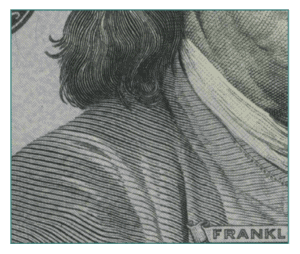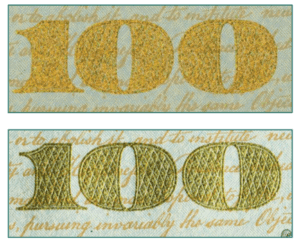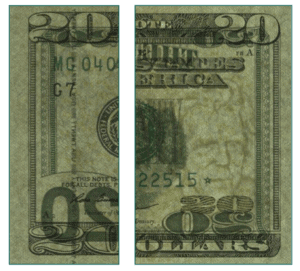When your business accepts fake bills, you bear the entire burden of the loss. And though it’s true that counterfeiters’ techniques are getting more and more complex, there are three strategies that business owners and employees can implement to help minimize losses from receiving counterfeit money:
- Feel the paper
- Tilt the note
- Check with light
 FEEL THE PAPER
FEEL THE PAPER
Genuine U.S. currency has a unique feel. The note should feel slightly rough to the touch. Ask yourself: Does it feel too soft or stiff? Does it feel too thick or thin? Does it feel too slick or smooth? If something feels off, you can quickly check the note’s security features.
 TILT THE NOTE
TILT THE NOTE
Tilt the note back and forth to observe the color-shifting ink. Color-shifting ink is found in the right-hand corner of denominations $10 and higher. A color shift from copper to green should appear on 2004 style notes.
The current style $100 includes two other security features you can check by titling. A 3-D security ribbon and Bell in the Inkwell.
 CHECK WITH LIGHT
CHECK WITH LIGHT
Check the watermark and security thread by holding to light. The watermark should be visible from both sides and matches the portrait or denomination. The security thread should be visible from both sides, matches the demonization, and glows a unique color when exposed to UV light.
A note on counterfeit detection pens.
Pens can generate false results. Pens detect the presence of starch found on commercially available paper. Counterfeiters can coat counterfeit notes to prevent proper chemical reactions or use bleached genuine notes.
Counterfeit reporting:
Contact your local police department or local U.S. Secret Service office.
- Write your initials and the date in the border of the note.
- Limit the handling of the note. Carefully place it in a protective covering, such as an envelope.
- Surrender the note only to a properly identified police officer or a U.S. Secret Service special agent.
Visit uscurrency.gov to learn more about U.S. currency and to explore interactive resources and tools.
